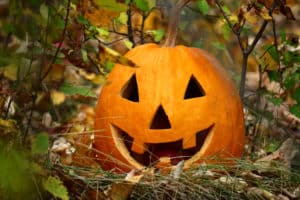Scary and haunted houses are great for Halloween, but not for the holidays.
The Complete Power Wash techs think the only thing scarier than a haunted house during Halloween, is a dirty house after Nov 1. Spider webs, black  and green streaks and shadowy grime are hallmarks of a spooky look for trick-or-treaters. However, this becomes a true frightening tale when you think that there is only one month until guests start arriving for Thanksgiving meals and conversations on porches and decks throughout the Tri-state area. This means time is running short to contact CPW‘s Hagerstown, MD office to schedule their pressure washing services. These cleaning services include house washing, roof cleaning and deck and patio cleaning. They use the softwash technique to safely clean your property, guaranteeing no damage to your home or property. This is something amateurs cannot do.
and green streaks and shadowy grime are hallmarks of a spooky look for trick-or-treaters. However, this becomes a true frightening tale when you think that there is only one month until guests start arriving for Thanksgiving meals and conversations on porches and decks throughout the Tri-state area. This means time is running short to contact CPW‘s Hagerstown, MD office to schedule their pressure washing services. These cleaning services include house washing, roof cleaning and deck and patio cleaning. They use the softwash technique to safely clean your property, guaranteeing no damage to your home or property. This is something amateurs cannot do.
 Contact the Complete Power Wash office if you would like to completely understand Jennifer’s pressure washing service experience. Click here, call 301.842.220 or email sandy@completepowerwash.com to connect.
Contact the Complete Power Wash office if you would like to completely understand Jennifer’s pressure washing service experience. Click here, call 301.842.220 or email sandy@completepowerwash.com to connect.
Click here to see a gallery of CPW‘s pressure washing work in the greater Hagerstown, MD area, including northern Frederick County. The professional cleaning techs also pressure wash residences and commercial buildings in nearby Greencastle, PA and Martinsburg, WV. They are also experts in industrial power washing, for those needing to clean facades or stubborn chemical stains.
While you’re trying to figure out the best day to book CPW‘s pressure washing experts, enjoy this Halloween trivia about the traditions many will celebrate this week.
Halloween Trivia
Why are pumpkins part of Halloween?
A: Pumpkins are actually indigenous to the Western Hemisphere and have been found on the continent for thousands of years. Pumpkins entered into the Halloween celebration after Irish immigrants came to America and found that pumpkins were easier to carve than potatoes for the holiday.
When did the Jack-’o-lantern become part of the autumn celebration?
A: Jack-’o-lanterns have been around for hundreds of years. The legend is of a man named Jack, who according to legend, invited the devil for a drink. Jack did not want to pay for his drink, so he made a deal with the devil. The devil turned himself into coins, but instead of paying for the drink, Jack kept  the coins. Later freeing the devil, he promised to change him back if he did not steal his soul. Upon Jack’s death, God would not let him into heaven because of his past and the devil would not let him into hell. Instead, the devil gave Jack a piece of coal, which Jack placed into a turnip. The legend goes that Jack used the turnip and coal to light his way as he looked for a final resting place. The original jack-’o-lanterns in Ireland were carved out of turnips or potatoes.
the coins. Later freeing the devil, he promised to change him back if he did not steal his soul. Upon Jack’s death, God would not let him into heaven because of his past and the devil would not let him into hell. Instead, the devil gave Jack a piece of coal, which Jack placed into a turnip. The legend goes that Jack used the turnip and coal to light his way as he looked for a final resting place. The original jack-’o-lanterns in Ireland were carved out of turnips or potatoes.
Who is responsible for bringing Halloween to America?
A: Halloween is mix of traditions from Celtic, Catholic and Roman religious rituals. Celts would dress in costumes and light bonfires to ward off ghosts, thought to return on Halloween. The Celts believe that the boundaries between the living and the dead blurred on Halloween, making it easier for ghosts and spirits to return to cause mischief.
When did candy corn become part of the celebration?
A: More than 35 million pounds of candy corn is produced each year according to the National Confectioner’s Association. Created in the late 1800s, the three colors are supposed to look like the colors in kernels of corn.
How did costumes become part of the holiday?
 A: Costumes were first worn to tell each other’s fortunes and for protection against evil spirits. The first costumes in Ireland were made of animal heads and skins. The modern celebration of Halloween still involves costumes, but many are not as creepy or scary as the first.
A: Costumes were first worn to tell each other’s fortunes and for protection against evil spirits. The first costumes in Ireland were made of animal heads and skins. The modern celebration of Halloween still involves costumes, but many are not as creepy or scary as the first.
Were witches always thought of as bad?
The word witch comes from the word “wica,” an Old Saxon word that means “wise one.” The early-known witches were dealers in medicinal herbs and charms and respected in their own communities. But superstitions were created and told of witches casting spells and making trouble for others. Settlers who arrived in America brought these superstitions, and coupled with the Native American belief in witches, the legend grew.



